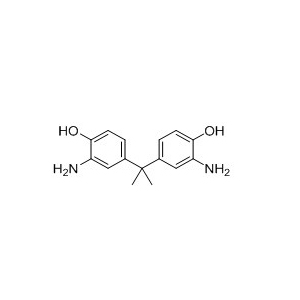Discover Aure Chemical's Premium BAP Supply
2,2-Bis(3-amino-4-hydroxyphenyl)propane (BAP), CAS 1220-78-6, also known as APA or 4,4'-Isopropylidenebis(2-aminophenol), is a diamino dihydroxy monomer featuring a propane core, enabling the synthesis of advanced polymers with excellent thermal stability, chemical resistance, mechanical properties, and flame retardancy.
Basic Information of BAP
| Product Name | 2,2-Bis(3-amino-4-hydroxylphenyl)propane |
|---|
| Abbreviation | BAP |
|---|
| CAS Number | 1220-78-6 |
|---|
| Molecular Formula | C15H18N2O2 |
|---|
| Molecular Weight | 258.32 g/mol |
|---|
| Appearance | White to yellow to orange powder to crystal |
|---|
| Purity | ≥99.5% |
|---|
| Package | 1kg/bottle, 20kg/drum, or customized |
|---|
| Molecular formula |  |
|---|
Key Properties
High thermal stability (high melting point)
Dual amine + hydroxyl functional groups for crosslinking / reactive modifications
Aromatic backbone ensures mechanical strength and rigidity
Good solubility in polar aprotic solvents (e.g. DMF) for polymerization
Moderate polarity and hydrogen bonding capability enhance adhesion / interface compatibility
Key Applications of BAP
High-Performance Polymers: Serves as a monomer for synthesizing polyimides, polyamides, and polybenzoxazoles (PBOs), used in aerospace composites, engineering plastics, and structural materials requiring heat resistance and durability.
Gas Separation Membranes: Incorporated into thermally rearranged polybenzoxazoles (TR-PBOs) derived from o-hydroxy polyimides, offering high gas permeability and selectivity (e.g., for CO₂/CH₄ separation, H₂ purification), ideal for natural gas processing and biogas treatment.
Electronics and Optoelectronics: Utilized in insulating materials for semiconductors, optical films, OLED/LCD displays, and electronic components, leveraging its low dielectric constant and electrical insulation properties.
Flame-Retardant Materials: Employed in epoxies, polyurethanes, composites, textiles, and coatings for fire safety applications, providing inherent flame resistance without additional retardants.
Energy Applications: Applied in high-temperature fuel cells and related components, benefiting from its stability in harsh environments.
Detailed COA / TDS / MSDS are available upon request. Please Contact Us for more information.

